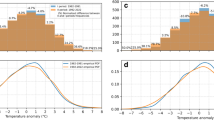Abstract
The rareness and inhomogeneity of the data points cause difficulties in the reconstruction of past average temperature. Optimal regional averaging is a method that can overcome these difficulties and obtain the average temperature of target area by means of optimal weights using limited temperature data. In this paper, the average temperature in the Northern Hemisphere is calculated by the optimal regional averaging method using two types of data: temperature data from Climatic Research Unit from 1901 to 2000 and maximum latewood density dataset of tree from 1500 to 1949. Five, ten, fifteen data points from CRU and forty data points from MXD are used in our research. The results show that even with the relatively less data used in this reconstruction, the method allows the reconstruction of the average temperature of the Northern Hemisphere more accurately, which provides the temperature information for palaeoclimate reconstruction.







Similar content being viewed by others
References
Vinnikov KY, Groisman PY, Lugina KM (1990) Empirical data on contemporary global climate changes (temperature and precipitation). J Clim 3:662–677
Shen SS, Smith TM, Ropelewski CF et al (1998) An optimal regional averaging method with error estimates and a test using tropical pacific SST data. J Clim 11:2340–2350
Trouet V, Diaz HF, Wahl ER et al (2013) A 1500-year reconstruction of annual mean temperature for temperate North America on decadal-to-multidecadal time scales. Environ Res Lett 8:024008
Shi F, Yang B, Mairesse A et al (2013) Northern Hemisphere temperature reconstruction during the last millennium using multiple annual proxies. Clim Res 56:231–244
Shi F, Yang B, Ljungqvist FC et al (2012) Multi-proxy reconstruction of Arctic summer temperatures over the past 1400 years. Clim Res 54:113–128
He YX, Liu WG, Zhao C et al (2013) Solar influenced late Holocene temperature changes on the northern Tibetan Plateau. Chin Sci Bull 58:1053–1059
Yang B, Tang LY, Li CH et al (2010) An ice-core record of vegetation and climate changes in the central Tibetan Plateau during the last 550 year. Chin Sci Bull 55:1169–1177
Ge QS, Liu HL, Zheng JY et al (2010) Reconstructing temperature change in Central East China during 601–920 AD. Chin Sci Bull 55:3944–3949
Sun Y, Wang LL, Chen J et al (2012) Reconstructing mean maximum temperatures of May–August from tree-ring maximum density in North Da Hinggan Mountains, China. Chin Sci Bull 57:2007–2014
Dai Y, Zhang Y, Ge JY (2011) Decadal-scale variability of warm season temperature in Beijing over the past 2650 years. Chin Sci Bull 56:2366–2370
Shi F, Yang B, Gunten VL et al (2012) Ensemble empirical mode decomposition for tree-ring climate reconstructions. Theor Appl Climatol 109:233–243
Shen SP, Wang XC, Liang YL et al (1995) Optimal weighting scheme for averaging temperature (I) Theoretical analysis. Chin Sci Bull 40:1005–1009
Tang GL, Wang SW, Wun XY et al (2011) Comparison of global mean temperature series. Adv Clim Change Res 7:85–89
Mann ME, Rutherford S, Wahl E et al (2005) Testing the fidelity of methods used in proxy-based reconstructions of past climate. J Clim 18:4097–4107
Lee TCK, Zwiers FW, Tsao M (2008) Evaluation of proxy-based millennial reconstruction methods. Clim Dyn 31:263–281
Esper J, Cook ER, Schweingruber FH (2002) Low frequency signals in long tree-line chronologies for reconstructing past temperature variability. Science 295:2250–2253
Briffa KR, Osborn TJ, Schweingruber FH et al (2001) Low-frequency temperature variations from a northern tree ring density network. J Geophys Res 106:2929–2941
Jones PD, Briffa KR, Barnett TP et al (1998) High-resolution palaeoclimatic records for the last millennium: integration, interpretation and comparison with general circulation model control run temperatures. Holocene 8:455–471
Hegerl GC, Crowley TJ, Allen MR et al (2007) Detection of human influence on a new, validated 1500-year temperature reconstruction. J Clim 20:650–666
Shen SS, Wang XC (1997) Optimal average of regional temperature with sampling error estimation. Atmos Ocean 35:147–160
Gandin LS (1965) Objective analysis of meteorological fields, Gidrometeoizdat, Leningrad. Translated by Israel Program Scientific Translations, Jerusalem, 242
Kagan RL (1979) Averaging meteorological fields. Gidrometeoizdat, Leningrad, p 212 (in Russian)
Shen SP, North GR, Kim KY (1994) Spectral approach to optimal estimation of the global average temperature. J Clim 7:1999–2007
Wigley TML, Briffa KR, Jones PD (1984) On the average value of correlated time series, with applications in dendroclimatology and hydrometeorology. J Clim Appl Meteorol 23:201–213
Liu HB, Zhou JX (2003) On the abnormal swing of the averaged time series produced from a number of correlated time series. Acta Meteorol Sin 61:488–493 (in Chinese)
Rutherford S, Mann ME, Osborn TJ et al (2005) Proxy based Northern Hemisphere surface temperature reconstructions: sensitivity to method, predictor network, target season, and target domain. J Clim 18:2308–2329
Briffa KR, Osborn TJ, Schweingruber FH et al (2002) Tree-ring width and density data around the Northern Hemisphere: part 1, local and regional climate signals. Holocene 12:737–757
Mann ME, Bradley RS, Hughes MK (1999) Northern Hemisphere temperatures during the past millennium: inferences, uncertainties, and limitations. Geophys Res Lett 26:759–762
Li JF, Yuan YJ, Yu XR et al (2000) Hydrology research and application of tree ring. Science Press, Beijing, pp 1–32 (in Chinese)
Wu XD (1990) Tree ring and climate change. China Meteorological Press, Beijing, pp 1–325 (in Chinese)
Wu XD (1990) Tree rings analysis application in environmental change research. Quat Res 2:188–196 (in Chinese)
Mann ME, Zhang ZH, Hughes MK et al (2008) Proxy-based reconstructions of hemispheric and global surface temperature variations over the past two millennia. Proc Natl Acad Sci USA 105:13252–13257
Acknowledgements
This work was supported by the National Basic Research Program of China (2010CB950104), and the Innovative Research Groups of the National Natural Science Foundation of China (11121202).
Conflict of interest
The authors declare that they have no conflict of interest.
Author information
Authors and Affiliations
Corresponding authors
About this article
Cite this article
Wang, C., Huang, N., Guo, J. et al. Reconstruction of the Northern Hemisphere temperature from 1500 to 1949 by optimal regional averaging method. Chin. Sci. Bull. 59, 4873–4880 (2014). https://doi.org/10.1007/s11434-014-0580-3
Received:
Accepted:
Published:
Issue Date:
DOI: https://doi.org/10.1007/s11434-014-0580-3




